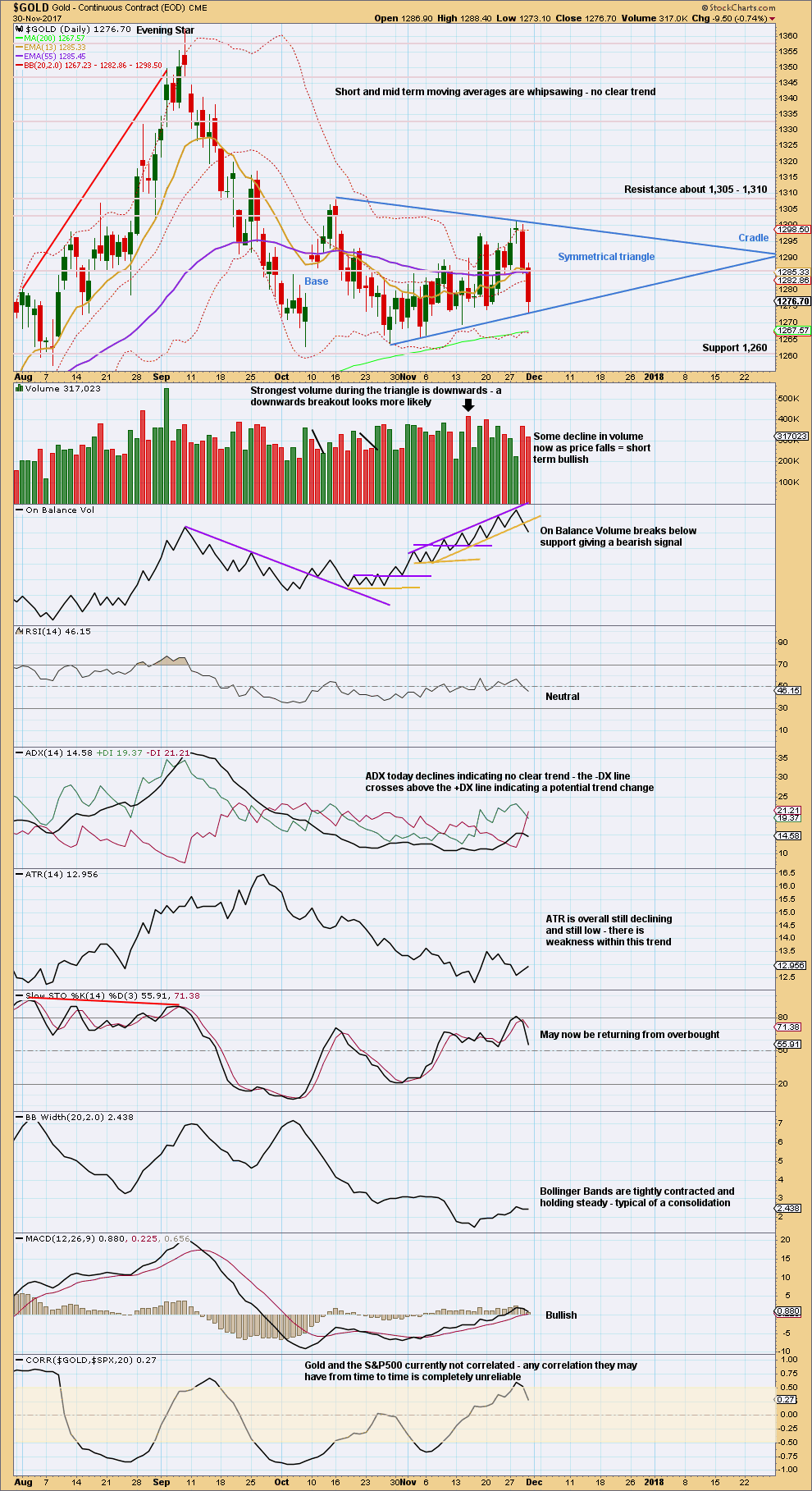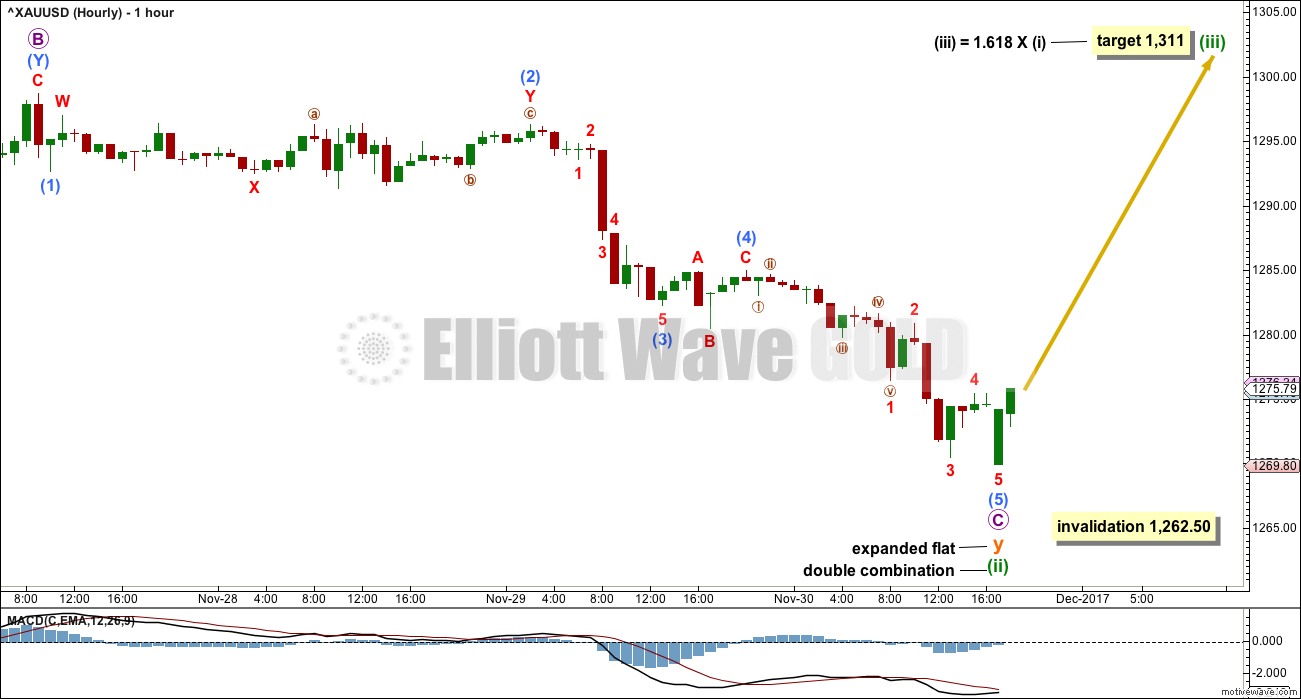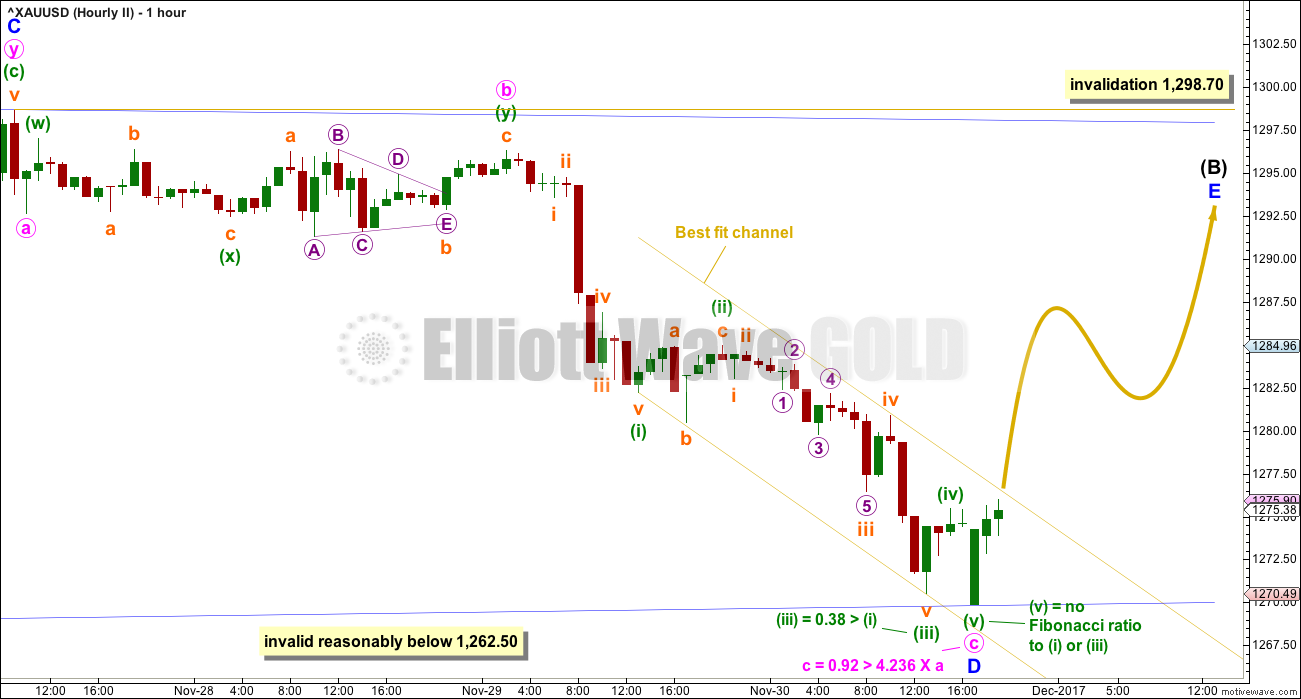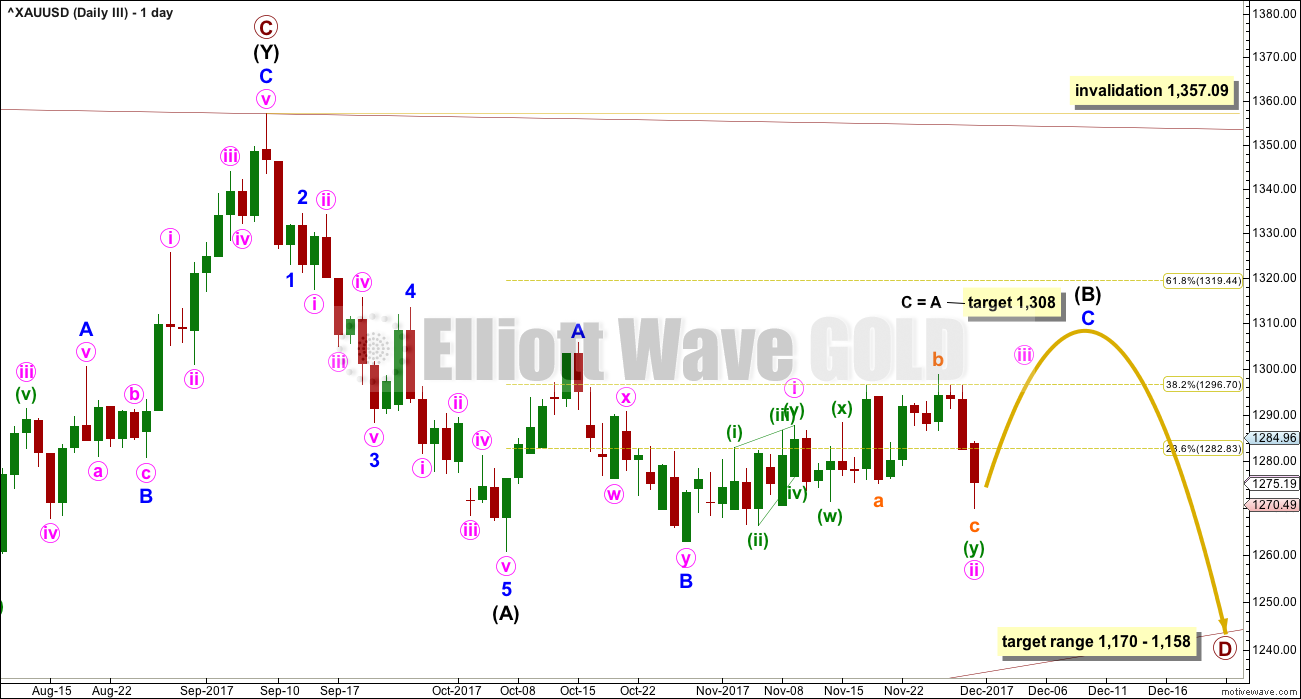The short term target for a little more downwards movement was 1,271. Downwards movement has continued and so far has reached 1,269.80, just 1.20 below the target.
Summary: Members please note: the second wave count is strongly preferred.
Only one final upwards swing is now required to compete an Elliott wave triangle. It may end in one to three days. Thereafter, price should break out downwards. Volume and a bearish signal today from On Balance Volume support this view.
Always trade with stops and invest only 1-5% of equity on any one trade.
New updates to this analysis are in bold.
Last monthly charts for the main wave count are here, another monthly alternate is here, and video is here.
Grand SuperCycle analysis is here.
To avoid swapping wave counts over while cycle wave b continues, they will be labelled in the order they were developed: first, second and third. At this time, the second wave count is preferred because its Elliott wave structure has a better fit and has more support from classic technical analysis.
FIRST ELLIOTT WAVE COUNT
WEEKLY CHART
Both wave counts expect that Gold completed a large five down from the all time high in November 2011 to the low of December 2015, which is seen on the left hand side of both weekly charts.
If this analysis is correct, then the five down may not be the completion of the correction. Corrective waves do not subdivide as fives; they subdivide as threes. The five down is seen as cycle wave a within Super Cycle wave (a).
Both wave counts then expect cycle wave b began in December 2015.
There are more than 23 possible corrective structures that B waves may take. It is important to always have multiple wave counts when B waves are expected.
It looks unlikely that cycle wave b may have been over at the high labelled primary wave W. Primary wave W lasted less than one year at only 31 weeks. Cycle waves should last one to several years and B waves tend to be more time consuming than other Elliott waves, so this movement would be too brief for cycle wave b.
This first wave count expects that cycle wave b may be an incomplete double zigzag.
While this first wave count is entirely possible, there are three problems now which reduce its probability.
1. Cycle wave b is a double zigzag, but primary wave X within the double is deep and time consuming. While this is possible, it is much more common for X waves within double zigzags to be brief and shallow.
2. Intermediate wave (B) within the zigzag of primary wave Y is a double flat correction. These are extremely rare, even rarer than running flats. The rarity of this structure must further reduce the probability of this wave count.
3. Although intermediate wave (C) should be continuing so that primary wave Y ends substantially above the end of primary wave W, the duration of minor wave 2 within it now looks to be too large at the weekly time frame.
Within intermediate wave (C), no second wave correction may move beyond the start of its first wave below 1,205.41. However, prior to invalidation, this wave count may be discarded if price breaks below the lower edge of the black Elliott channel. If this wave count is correct, then intermediate wave (C) should not break below the Elliott channel which contains the zigzag of primary wave Y upwards.
DAILY CHART
The analysis will focus on the structure of intermediate wave (C). To see details of all the bull movement for this year see daily charts here.
Intermediate wave (C) must be a five wave structure, either an impulse or an ending diagonal. It is unfolding as the more common impulse.
Minor wave 1 was a long extension. The target for minor wave 3 expects that too may be a long extension. If this is the case, then minor wave 5 may be shorter (only two actionary waves in an impulse may be extended).
The target for minute wave iii fits with higher targets and expects it to exhibit the most common Fibonacci ratio to minute wave i.
If price makes a new high above 1,357.09, then the second wave count below would be discarded and more confidence may be had in this first wave count.
This first wave count now expects there should be a series of three overlapping first and second waves: minor, minute, and minuette. A support line is added in lilac to show where price has found support for the last few weeks.
HOURLY CHART
This hourly chart shows the latter half of a possible double combination, labelled minuette wave (ii).
The first structure in a double combination may have been a zigzag labelled subminuette wave w. This is now seen only on the daily chart.
The double is joined by a three in the opposite direction, a zigzag labelled subminuette wave x, also visible now only on the daily chart.
The second structure in the double may be an expanded flat correction labelled subminuette wave y. Within this expanded flat, only the structures of micro waves B and C are now shown on the hourly chart.
Within the expanded flat of subminuette wave y, micro wave B is now a 1.79 length to micro wave A. While there is no Elliott wave rule stating a limit to B waves within flats, there is a convention which states that the idea of an expanded flat should be discarded when a B wave reaches twice the length of the A wave.
Micro wave B is now seen as a double zigzag ending at Monday’s high. This does not have as good fit as last analysis.
Micro wave C now needs to be a five wave structure downwards. This may now be complete. Micro wave C has moved below the end of micro wave A at 1,275.18 avoiding a truncation and a very rare running flat. The structure may now be complete.
This first wave count (and the third wave count) now expect to see upwards movement that should show strong momentum as a third wave at three degrees begins.
SECOND ELLIOTT WAVE COUNT
WEEKLY CHART
Both wave counts are identical to the low labelled cycle wave a. Thereafter, they look at different possible structures for cycle wave b.
This wave count looks at cycle wave b to be most likely a regular contracting triangle.
The B-D trend line should have a reasonable slope for this triangle to have the right look, because the A-C trend line does not have a strong slope. A barrier triangle has a B-D trend line that is essentially flat; if that happened here, then the triangle trend lines would not converge with a normal look and that looks unlikely.
Primary wave D should be a single zigzag. Only one triangle sub-wave may be a more complicated multiple, and here primary wave C has completed as a double zigzag. This is the most common triangle sub-wave to subdivide as a multiple.
Primary wave D of a contracting triangle may not move beyond the end of primary wave B below 1,123.08.
At its completion, primary wave D should be an obvious three wave structure at the weekly chart level. Within primary wave D, intermediate wave (B) is incomplete. At this stage, it looks like intermediate wave (B) may be unfolding as a triangle. This now has a better fit at the daily and hourly chart level. At its conclusion, intermediate wave (B) should look like a corrective structure at the weekly chart level.
DAILY CHART
This is the preferred wave count.
A common length for triangle sub-waves is from 0.8 to 0.85 the length of the prior wave. Primary wave D would reach this range from 1,170 to 1,158.
Primary wave D should subdivide as a zigzag, and within it intermediate wave (B) looks incomplete.
So far intermediate wave (B) has lasted thirty-nine sessions; it is incomplete and needs several more sessions now to complete. If intermediate wave (B) completes as a triangle, then it may either not exhibit a Fibonacci duration, or it may last a total Fibonacci fifty-five sessions. If it were to last a total Fibonacci fifty-five sessions, it wold continue for another month. With only the final sub-wave of minor wave E now required, it looks like intermediate wave (B) may end now within another one to three days.
Within the triangle of intermediate wave (B), it may be minor wave C which has completed as a multiple zigzag. This is the most common triangle sub-wave to subdivide as a multiple.
For a contracting triangle, minor wave D may not move beyond the end of minor wave B below 1,262.50. For a barrier triangle, minor wave D may end about the same level as minor wave B at 1,262.50. The triangle for intermediate wave (B) will remain valid as long as the lower B-D trend line remains essentially flat. Unfortunately, this is the only Elliott wave rule which is not black and white; it involves a subjective grey area.
Minor wave E would most likely fall short of the A-C trend line. If it does not end there, it may overshoot the trend line slightly. Minor wave E may not move beyond the end of minor wave C above 1,298.70.
Triangles normally adhere very well to their trend lines and fairly often the trend lines are tested within the triangle sub-waves.
HOURLY CHART
Minor wave D downwards may now be complete. A yellow best fit channel is drawn about minute wave c. When this channel is breached clearly by upwards movement, it shall provide confidence that minor wave D downwards is over and minor wave E upwards should be underway.
Minor wave E must subdivide as a single three wave structure. It would most likely be a zigzag, but it does not have to. There is an outside possibility that it could subdivide as a triangle, so that the whole of intermediate wave (B) is a longer lasting nine wave triangle. If that happens, then intermediate wave (B) could continue for another week or so.
When minor wave E looks like a three and falls short of the A-C trend line, then it could be over. When triangles come to a conclusion, then next movement out of them is almost always very swift and sharp.
Upon conclusion of the triangle the breakout is expected to be downwards.
THIRD ELLIOTT WAVE COUNT
DAILY CHART
This third wave count looks at intermediate wave (B) as a flat correction. Within a zigzag, minor wave C would need further upwards movement for the structure to complete. The target at 1,308 remains the same.
Minor wave C must subdivide as a five wave structure. So far within it, minute waves i and ii, and minuette waves (i) and (ii), may be complete.
Analysis of most recent movement is seen in the same way as for the first wave count.
At the hourly chart level, this third wave count sees subdivisions for most recent movement of the last few weeks in the same way as the first wave count. The degree of labelling would be one degree higher.
Because this third and the first wave count are the same at the hourly chart level, only one will be published at this time.
TECHNICAL ANALYSIS
WEEKLY CHART

Click chart to enlarge. Chart courtesy of StockCharts.com.
On Balance Volume is constrained. The last signal given was bearish.
DAILY CHART

Click chart to enlarge. Chart courtesy of StockCharts.com.
A classic symmetrical triangle looks now to be forming. Regarding triangles from Kirkpatrick and Dhalquist:
“The breakout is usually upward (54% of the time). Symmetrical triangles have many false breakouts and must be watched carefully. A trick breakout system must be used that allows for such false moves. The breakout commonly occurs between 73% and 75% of the length of the triangle from base to cradle… Throwbacks and pullbacks occur 37% to 59% of the time, respectively, and, as in most patterns, when they occur, they detract from eventual performance. This implies that for actual investement or trading, the initial breakout should be aced upon, and if a pullback or throwback occurs, the protective stop should be tightened. It does not imply that a pullback or throwback should be ignored, but that instead, performance expectations should be less than if no pullback or throwback had occurred.”
On trading triangles:
“The ideal situation for trading triangles is a definite breakout, a high trading range within the triangle, an upward-sloping volume trend during the formation of the triangle, and especially a gap on the breakout… An initial target for these patterns is calculated by adding the be distance – the vertical distance between the initial upper and lower reversal point prices – to the price where the breakout occurred.”
For the short term, because volume has declined and the last candlestick has a slightly longer lower wick, it looks like this downwards swing may be over here. That would also see this downwards swing end at the lower support line for the triangle, which has been tested four times before and thus offers reasonable technical significance.
Volume and On Balance Volume suggest a downwards breakout from this triangle.
GDX DAILY CHART

Click chart to enlarge. Chart courtesy of StockCharts.com.
A descending triangle looks to be forming now for GDX. From Kirkpatrick and Dhalquist regarding descending triangles:
“The breakout is more common to the downside (65%), but the upward breakout is more reliable and profitable… This formation can be stretched high and wide and is sometimes difficult to recognise. The trend lines defining its boundaries are almost never exact and are loaded with false intra-bar breakouts. A strict breakout strategy is required… However, prices often explode out of it and produce sizeable gains. It can also be wild and guarantee an exciting ride. It will break out and run, break out and pull back to its trend line, break out and pull back to its cradle, or break back through the cradle, create a sizeable trap, and then reverse back in its original breakout direction and run. In other words, when you enter on a breakout from a descending triangle, the subsequent action must be watched carefully.”
Published @ 09:07 p.m. EST.








Triangles everywhere at the moment. Aussie miners look far more bullish than GDX. An ascending triangle and congestion between support and resistance. It’s gonna break one way or the other pretty soon.
Tax loss selling at present impacting GDX and GDXJ I suspect.
Hey Stuart, thanks for the post. I don’t follow any international indices, but decided to take a closer look at your post by comparing it to the USD GDX on one chart.
This is what I see. They normally track each other closely, but for the last 2+ years, the Aussie miners have outperformed as you noted.
I also took a stab at a slightly different count. There may be an EW Barrier triangle on the Aussie chart that’s very close to a breakout. Something to watch for sure!
https://www.tradingview.com/x/Q06lQJBW/
Thanks very much as I had not considered that idea! It looks very possible that this is correct. A little surprised to see GDX so weak, but some of the larger components dragging it down. It’s a very volatile and sentiment driven asset class.
Anything held at this point in time in the last few years has been profitable in the new year. I have been wondering about a repeat too.
Yep, I’m bullish, but don’t want to be overconfident as there are so many conflicting signals. We should know soon…
If members are not already positioned prior to the breakout, now may be a good time to enter short or for an entry to the short side of a hedge.
Stops for the short side should now be just above 1,298.70. Always always trade with stops, it’s essential risk management. Adjust position size so that you risk only 1-5% of equity. Less experienced members should adjust position size to 1-3% of equity. Don’t get greedy and risk more.
I’m tentatively labelling the triangle for intermediate (B) as complete. Minor E is now a three wave structure and ends nicely at the 0.618 Fibonacci ratio of minor D. It falls well short of the A-C trend line which is actually a pretty common point for triangles to end.
It does however look very brief on the daily chart so we must accept the risk here that minor E could continue higher. Minute c may have only the first wave complete, and now a second wave down may be unfolding.
A better target may now be calculated for primary D to end.
If this wave count is right and a downwards breakout is to come very early next week, then a short position may be held for a few weeks. This could be a good trade.
And a note about membership:
I have noticed a pattern over the years. When price consolidates and / or when ATR declines, people cancel their membership. Plenty of them come back again but they only do so AFTER price has broken out and starts to trend again. Then they want me to find them an entry point.
A bit of patience along with good risk management may see those who stay find a better entry point if I get the breakout direction right.
A good lagging indicator ??? 🙂
Possibly. But a most annoying one.
I got filled in anticipation of that spike up for E. You could not ask for a better set-up in my opinion. You literally handed it to us on a Silver, no, A Gold platter! 🙂
Recent experience with another trade reminded me once again that E waves can be sharp and quick so you have to anticipate the rapid reversal….
Yep. E waves have surprised us before. This one could certainly continue higher, but IMO now is the better entry point. If it does continue higher the position shouldn’t be underwater for too long. If it does not continue higher then this is a perfect entry for a short.
Based on the last 3 years, we are in the time range for a significant bottom. It’s not a sure thing as cycles can invert, but it does give support to the idea of a bottom about now
https://www.tradingview.com/x/x6kAiyFd/
Over a week ago, I first shared the idea of an ending contracting diagonal for the junior miners. So far, this idea has played out as anticipated. Today a new low was made and the pattern is likely complete. Let’s see if a strong move up can take hold now.
A move below 31.19 would be bearish and invalidate the ending diagonal.
https://www.tradingview.com/x/OJ2Y73No/
Triangles are one of my favorite “bread and butter” structures to trade. As Lara noted, the price movement out of them tends to be very predictable and there are very clearly defined levels that tell you when you are wrong. Looking forward to deployment of some good sized bear call spreads as we head back up in minor E with hard stop just above invalidation point of 1298.70 Triangles really require lots of patience to let them play out but well worth the wait! 🙂